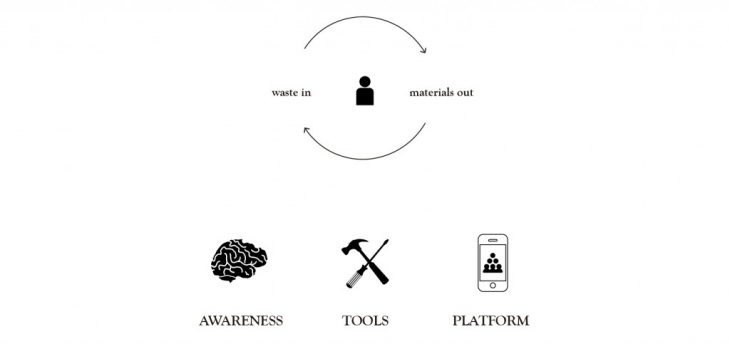
In the very beginning of the project we wanted to identify main problems of La Barceloneta neighbourhood. The biggest issue that locals named turned to be tourism. Since this problem is very wide we wanted to tackle reasons why do tourists come to La Barceloneta. Clearly the main attractor is beach. Despite that, with the second reason we discovered the topic food cycle. To understand both tourism and food provenance in area we did surveys. Targets were restaurants, shops (particularly pakis and fish shops), hotels and tourists. From interviews results the gap between two types of restaurants appeared: one type of chain restaurants in Passeig de Borbo, and the other with restaurants located in inner part of neighbourhood. Fist group do not recycle much, and the second one appeared more responsible. In terms of fish shops it was exciting that they do not produce waste or produce a very small amount of it, since they calculate their demand everyday very precisely. Hotels seemed not so open to share their habits. The tourists confirmed predictions that most of them consider eating activities in La Barceloneta.
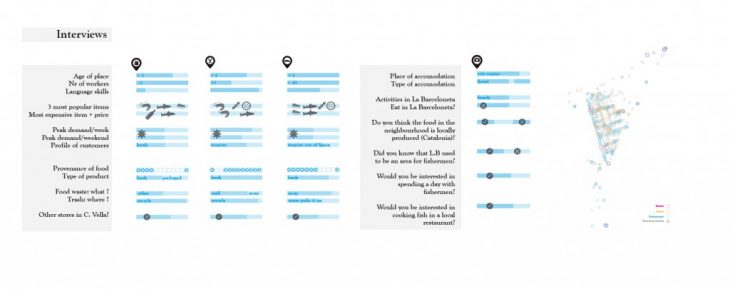 Also in order to identify the first step of fish cycle we visited the fishermen port, that is hidden in behind posh yachts. There it was discovered that the fish provenance is well developed here: all the fish boxes in auction have tags with boat name (indicating fishing type), location, time. Also, here we find out who get direct damage of sea pollution: these are fishermen, who have to do frustrating nets cleaning from micro-plastic after every trip to the sea. After fish is sold in auction it is delivered to restaurants or market (some of it even by ecologic bike-trolleys). And after consuming fish or other sea food restaurants have a lot of leftovers from cooking (inedible parts of sea food), that is thrown away as an organic waste. Also, edible uneaten food usually is given to the staff or poor people. After food becomes waste it disappears from Barceloneta for ever- part of it, as a organic waste goes to energy plant and is turned into energy (but from there it is distributed only to Poblenou area), other parts just end up in landfills or somewhere else.
Also in order to identify the first step of fish cycle we visited the fishermen port, that is hidden in behind posh yachts. There it was discovered that the fish provenance is well developed here: all the fish boxes in auction have tags with boat name (indicating fishing type), location, time. Also, here we find out who get direct damage of sea pollution: these are fishermen, who have to do frustrating nets cleaning from micro-plastic after every trip to the sea. After fish is sold in auction it is delivered to restaurants or market (some of it even by ecologic bike-trolleys). And after consuming fish or other sea food restaurants have a lot of leftovers from cooking (inedible parts of sea food), that is thrown away as an organic waste. Also, edible uneaten food usually is given to the staff or poor people. After food becomes waste it disappears from Barceloneta for ever- part of it, as a organic waste goes to energy plant and is turned into energy (but from there it is distributed only to Poblenou area), other parts just end up in landfills or somewhere else.
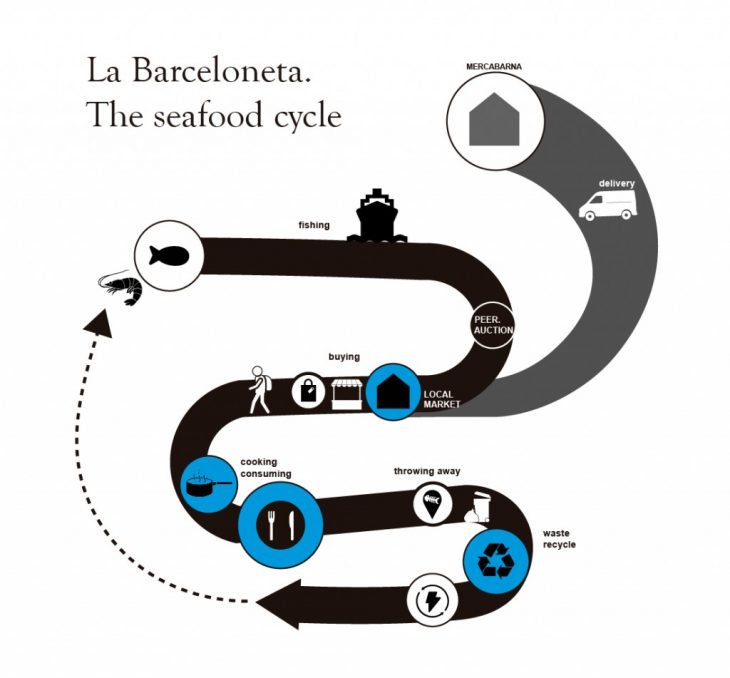
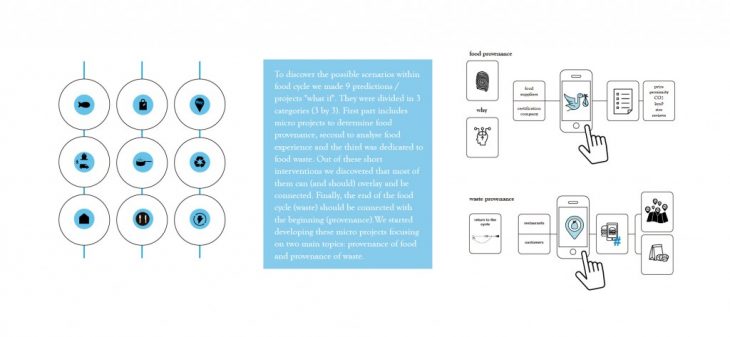 After identifying food provenance in area and realising the amounts of waste we have, our project shifted into research of waste chain.
After identifying food provenance in area and realising the amounts of waste we have, our project shifted into research of waste chain.
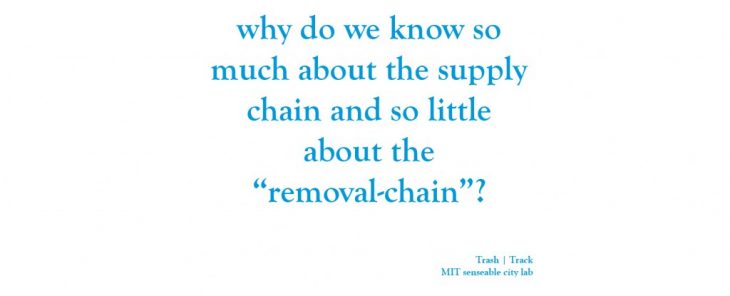 Today we produce more waste than ever- one citizen of Barcelona produce 1.21 kg of waste per day. Out of it we recycle only 38% and the biggest amount of sorted materials consist of organic waste, paper, glass and plastic. The biggest producers of waste are households and offices. „La Barceloneta is one of the five city neighbourhoods with the highest amounts of gross organic waste collected and its percentage of “unsuitable”, waste deposited in the wrong place (29.10%) is higher than the city’s average of 22.21%. This Ciutat Vella neighbourhood also has a higher number of bars and restaurants, establishments that are seen as big generators of organic waste and which therefore require special treatment when it comes to planning the initiatives to be carried out.” – Area Metropolitana de Barcelona, 2016.
Today we produce more waste than ever- one citizen of Barcelona produce 1.21 kg of waste per day. Out of it we recycle only 38% and the biggest amount of sorted materials consist of organic waste, paper, glass and plastic. The biggest producers of waste are households and offices. „La Barceloneta is one of the five city neighbourhoods with the highest amounts of gross organic waste collected and its percentage of “unsuitable”, waste deposited in the wrong place (29.10%) is higher than the city’s average of 22.21%. This Ciutat Vella neighbourhood also has a higher number of bars and restaurants, establishments that are seen as big generators of organic waste and which therefore require special treatment when it comes to planning the initiatives to be carried out.” – Area Metropolitana de Barcelona, 2016.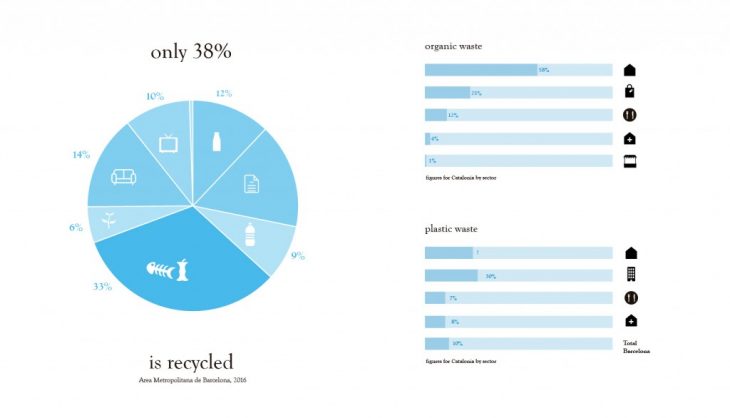 At this point we discovered Fabrica del Sol which is one of three Ateneus in Barcelona. This Ateneu particularly is focused on sustainability. During meetings with Fabrica del Sol, who are responsible for sustainability in Barceloneta neighbourhood, it was clear that the biggest issue we face today is people awareness about recycling. There we came to our main subject of project – waste recycling. It is obvious that in order to make material locally we can use unlimited resource which is everywhere- waste.
At this point we discovered Fabrica del Sol which is one of three Ateneus in Barcelona. This Ateneu particularly is focused on sustainability. During meetings with Fabrica del Sol, who are responsible for sustainability in Barceloneta neighbourhood, it was clear that the biggest issue we face today is people awareness about recycling. There we came to our main subject of project – waste recycling. It is obvious that in order to make material locally we can use unlimited resource which is everywhere- waste.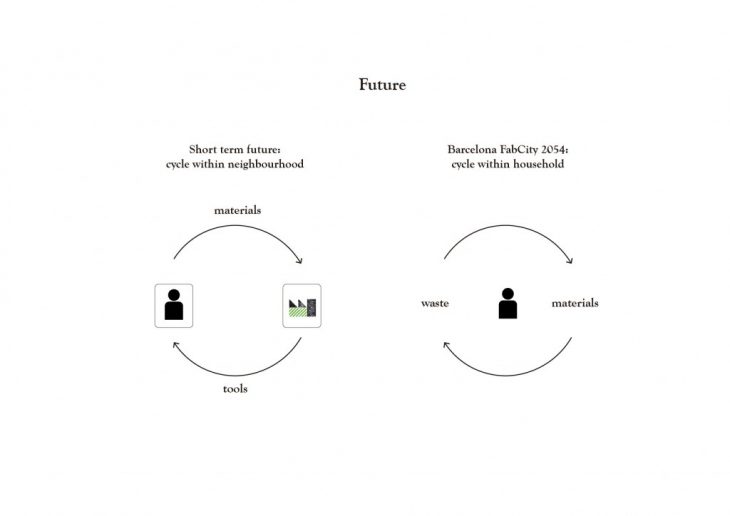 In order to enable this cycle and turning waste into material we proposed time-considering strategies in order to achieve that: raising awareness (today), developing easy accessible tools (short-term future), developing a platform to enable sharing tools, materials (waste), collaborations (long-term future).
In order to enable this cycle and turning waste into material we proposed time-considering strategies in order to achieve that: raising awareness (today), developing easy accessible tools (short-term future), developing a platform to enable sharing tools, materials (waste), collaborations (long-term future).
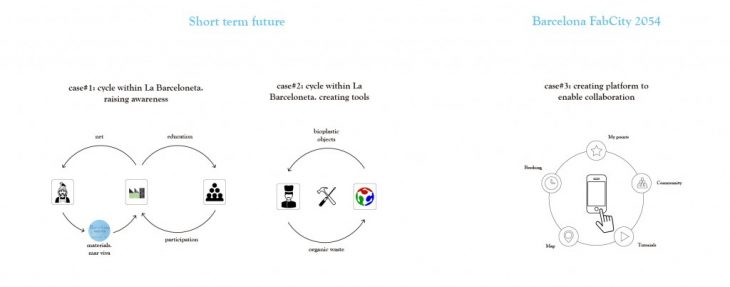 For our following case studies we chose two main directions- bio waste and development of bio packaging for food (turning food waste to be useful for food again) and plastic from sea cycle into nets for fishermen (using plastic that is caught by fishermen while fishing with nets). To implement these ideas we have also created schedule for the rest of the term in FabCity course.
For our following case studies we chose two main directions- bio waste and development of bio packaging for food (turning food waste to be useful for food again) and plastic from sea cycle into nets for fishermen (using plastic that is caught by fishermen while fishing with nets). To implement these ideas we have also created schedule for the rest of the term in FabCity course.
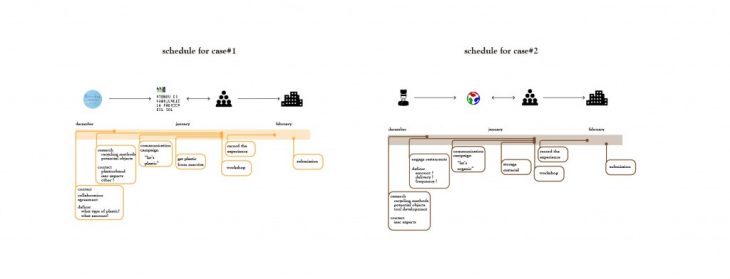
La Barceloneta. Cycles is a project of IAAC, Institute for Advanced Architecture of Catalonia, developed at MaCT (Master in City & Technology), 2017-18 by:
Students: Saule Gabriele Petraityte, Alba Alsina
Faculty: Tomas Diez, Mathilde Marengo, Chiara Dallolio